The Republic of China Air Force yesterday used a closed-off motorway as a runway in a rare drill simulating a surprise attack from China that had wiped out its major airbases.
In all, six fighter aircraft landed and took off from Freeway No. 1 in an emergency landing and takeoff exercise, under the watchful eye of hundreds of spectators.
The one-hour drill anticipated a scenario in which runways at airbases in Greater Kaohsiung’s Gangshan Township (岡山), Penghu’s Magong (馬公), Pingtung and Greater Tainan were destroyed by three waves of missile attacks by China, forcing the air force to use alternative locations for landing and takeoff, the Ministry of National Defense said.
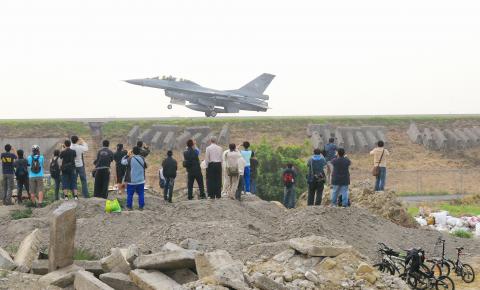
Photo: Huang Chih-yuan, Taipei Times
“In today’s scenario, we assumed most of Taiwan’s military air bases were severely damaged in an attack by missiles from the People’s Liberation Army, and fighter jets could not return to their home bases,” an air force spokesman told reporters.
“Because of that we needed to convert some sections of the freeway to serve as emergency runways ... and for that purpose, we need to check the standard procedures, like clearing up the road surface, setting up communications networks and installing plane arrest cables,” he said.
In the exercise, which began at 7:26am in heavy fog, two Indigenous Defense Fighters (IDF), two F-16A/Bs and two Mirage 2000s landed on a 2.7km stretch of Freeway No. 1 in the Madou area of Greater Tainan. More than 1,300 members of the armed services participated in the exercise.
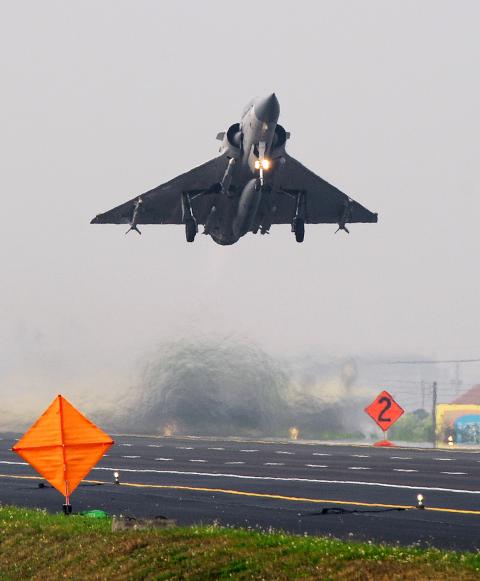
Photo: AFP
The IDF fighters took off from Tainan Air Base, while the F-16s and Mirage 2000s took off from Chiashan Base (佳山) in Hualien County.
To ensure the planes could land safely, a large number of soldiers were ordered to carry out a meticulous search for stones or other small objects on the road.
Several cars also drove along the motorway, releasing high-frequency sounds to scare away birds that might be sucked into the turbines of the jets.
As the six combat aircraft landed on the freeway, an army OH-58D scout helicopter carried out surveillance and an AH-1W Super Cobra attack helicopter provided protection for a CH-47 Chinook transport helicopter carrying bombs and missiles for the fighter aircraft.
Security checks, refilling and missile reloading on the six aircraft were accomplished within one hour. Each IDF aircraft was loaded with six Mk 82 bombs, while each F-16 was fitted with AGM-65 Maverick and AGM-84 Harpoon missiles and the Mirage 2000s were loaded with MICA missiles.
At 8:26am, the six combat aircraft took off at intervals of one minute.
The Madou section of the freeway was closed from 4am until 10am yesterday.
The drill was part of the five-day Han Kuang 27, an annual series of exercises that began on Monday and end on Friday.
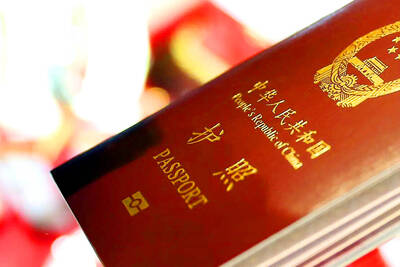
The Ministry of the Interior (MOI) is to tighten rules for candidates running for public office, requiring them to declare that they do not hold a Chinese household registration or passport, and that they possess no other foreign citizenship. The requirement was set out in a draft amendment to the Enforcement Rules of the Public Officials Election and Recall Act (公職人員選舉罷免法 ) released by the ministry on Thursday. Under the proposal, candidates would need to make the declaration when submitting their registration forms, which would be published in the official election bulletin. The move follows the removal of several elected officials who were
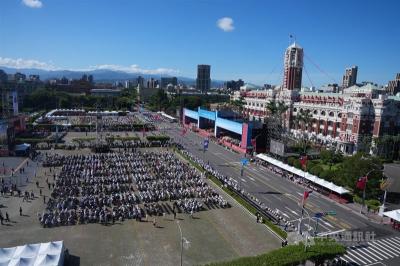
The Republic of China (ROC) is celebrating its 114th Double Ten National Day today, featuring military parades and a variety of performances and speeches in front of the Presidential Office in Taipei. The Taiwan Taiko Association opened the celebrations with a 100-drummer performance, including young percussionists. As per tradition, an air force Mirage 2000 fighter jet flew over the Presidential Office as a part of the performance. The Honor Guards of the ROC and its marching band also heralded in a military parade. Students from Taichung's Shin Min High School then followed with a colorful performance using floral imagery to represent Taiwan's alternate name
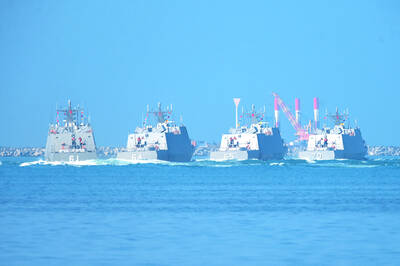
FOUR DESIGNATED AREAS: Notices were issued for live-fire exercises in waters south and northwest of Penghu, northeast of Keelung and west of Kaohsiung, they said The military is planning three major annual exercises across the army, navy and air force this month, with the navy’s “Hai Chiang” (海強, “Sea Strong”) drills running from today through Thursday, the Ministry of National Defense said yesterday. The Hai Chiang exercise, which is to take place in waters surrounding Taiwan, would feature P-3C Orion maritime patrol aircraft and S-70C anti-submarine helicopters, the ministry said, adding that the drills aim to bolster the nation’s offshore defensive capabilities. China has intensified military and psychological pressure against Taiwan, repeatedly sending warplanes and vessels into areas near the nation’s air defense identification zone and across

A Chinese takeover of Taiwan would severely threaten the national security of the US, Japan, the Philippines and other nations, while global economic losses could reach US$10 trillion, National Security Council Deputy Secretary-General Lin Fei-fan (林飛帆) wrote in an article published yesterday in Foreign Affairs. “The future of Taiwan is not merely a regional concern; it is a test of whether the international order can withstand the pressure of authoritarian expansionism,” Lin wrote in the article titled “Taiwan’s Plan for Peace Through Strength — How Investments in Resilience Can Deter Beijing.” Chinese President Xi Jinping’s (習近平) intent to take Taiwan by force